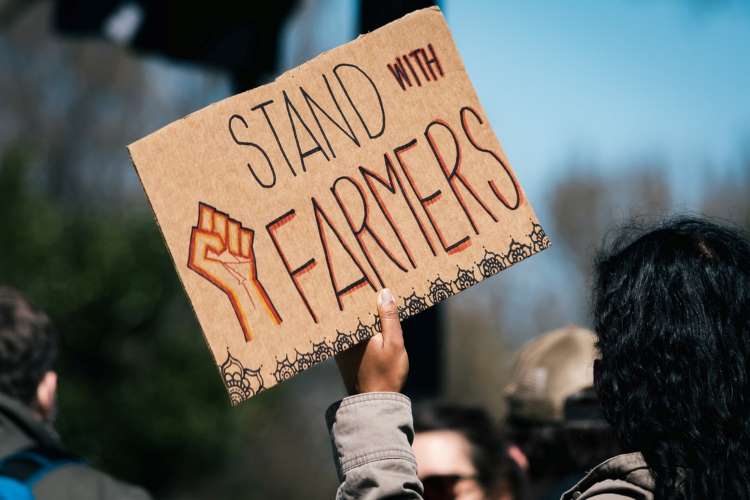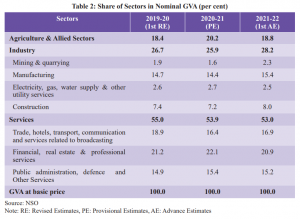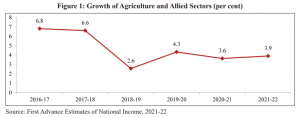
Budget 2022 disappoints the farm sector: When the Narendra Modi government repealed the three controversial farm laws in November 2021, no one had any doubt about the reason for the hurried action. It was clear that the government was trying to douse the anger among the farming community ahead of the crucial assembly elections in five states. The biggest compulsion would have been the polls in Uttar Pradesh, a state the ruling coalition can ill-afford to lose.
The commentators were unanimous that the government will pacify the farmers by pumping money into the crisis-ridden agricultural sector. They believed that Union Budget 2022-23 would contain some big announcement specifically targeted at the farming community in North India. Surprisingly, the government decided not to have any major measure for the sector that employs roughly 42.6% of India’s workforce and contributes 20.19% of the gross domestic product.


The reaction to the Budget 2022-23 from farmers unions and the agriculture industry were indicative of the direction of the policies. Farmers unions were quick to attack the government, alleging that it was taking revenge on farmers who forced it to withdraw the farm laws brought in with fanfare. However, the agriculture industry welcomed the Budget, saying the efforts towards strengthening infrastructure and promoting technologies will help farming activities.
One cannot blame farmers for reacting the way they did. There is hardly a noise about doubling farmers’ incomes nor is there any hike in PM Kisan pay-outs. There were expectations that the finance minister will pump money into the agricultural sector considering that the bulk of the people who lost their jobs in manufacturing and services will crowd the sector, which is already burdened by low productivity and disguised unemployment.
READ I Timely action on inflation needed to avert hard landing, says Maurice Obstfeld
Fiscal prudence of Budget 2022
The Union Budget 2022 has earmarked Rs 1.24 lakh crore for the Department of Agriculture and Farmers’ Welfare. This is nearly 3.1% of the projected expenditure of the government. The agricultural sector is under tremendous pressure due to disguised unemployment and low productivity. Headline-grabbing announcements like doubling of farmers’ incomes have been replaced by more pragmatic steps.
The three flagship schemes will consume most of the outlay for agriculture. PM Kisan will get Rs 68,000 crore, interest subvention on loans will get Rs 19,500 crore, and the Fasal Bima Yojana (crop insurance scheme) will get Rs 15,500 crore. The Budget has increased the allocation for the Rashtriya Krishi Vikas Yojana, launched in 2007-08, which allows state governments to allocate funds based on local conditions. There is a 422% increase in allocation to Rs 10,433 crore which will give the scheme a fresh lease of life. The Krishi Unnati Yojana, launched in 2016-17, as a bunch of 10 green revolution schemes, has been rejuvenated in the 2022-23 Budget with an outlay of Rs 7,183 crore.
The government has budgeted Rs 2.37 lakh crore for procuring paddy and wheat under the minimum support price scheme. However, there was no plan for the expansion of the MSP regime. The year 2023 has been named as the International Year of Millets. The government will support value addition and consumption of millets for branding millet products in domestic and global markets.
The finance minister has actually reduced allocation for PM Asha, a scheme to stabilise prices of oil seeds, to just Rs 1 crore from Rs 400 crore last year. This is because the market price of oil seeds is higher than the minimum support price offered under the scheme. The government will implement a scheme to raise domestic production of oilseeds to cut dependence on edible oil imports.
READ I Jal Jeevan Mission takes off, but drinking water for all still a distant dream
Stung by the farmer strike that forced the withdrawal of the three farm laws, the Narendra Modi government seems to have reset priorities in the sector. Sitharaman has announced a scheme to use crop residues for thermal power production, instead of allocating funds to bring down stubble burning that results in a spike in air pollution in Delhi and other north Indian cities. There has also been an increase in allocations for animal husbandry and fisheries, clearly reflecting their ability to generate rural jobs.
The Budget has cut the allocation for the department of fertilisers, reducing it drastically from Rs 1,49,663.28 crore to Rs 1,09,242.23 crore on the expectations of a fall in urea prices globally.
To benefit from the advancements in technology, the government will promote ‘kisan drones’ for the digitisation of land records, spraying nutrients and crop assessment. The FM also announced the government’s plans to promote chemical-free natural farming and public-private partnerships to deliver digital services to farmers. NABARD will introduce a fund to finance start-ups in agriculture and rural enterprise.
In a surprising decision, the government reduced fund allocation to MGNREGA, the government’s rural employment guarantee scheme. It was widely expected that there will be an increase in allocation for the scheme in view of the job losses due to the Covid-19 pandemic and the lockdown measures taken by the government.
Overall, it has been a disappointing Budget for the sector and the farming community. The government may have to raise allocations beyond the Budget outlay for the year because of uncertainties about the trajectory of the Covid-19 pandemic and the unemployment situation in the country.
One has to wait and see if the disappointment caused by Budget 2022 will have a bearing on election results. Farmers are central to BJP’s chances of retaining Uttar Pradesh and wresting Punjab from a faction-ridden Congress. While nobody is giving it a serious chance in Punjab, the ruling party is on a strong wicket in India’s most populous state. Samajwadi Party’s Akhilesh Yadav, BJP’s main rival in Uttar Pradesh, has promised a slew of measures targeted at farmer votes. Not to be left behind, BJP also has made several announcements. Only time can tell if these came a bit too late for the ruling party.

